Plastic bottles are a common sight in the modern world, as they’re used as containers for many different types of liquids.
However, not all plastic bottles are created equally; there are seven different types that you might come across on the shelves or at recycling centers.
These plastics vary greatly in their durability and cost-effectiveness, and knowing which type one is dealing with can be helpful when it comes to deciding what to do with them. This blog post will explore those 7 common types of plastic bottles.
Why Are There Different Types of Plastic Bottles?
There are different types of plastics because they can be designed to have specific properties, such as being able to hold liquids without leaking or being transparent.
Different types of plastics also vary in their stiffness and flexibility so not all items will work well with each kind of plastic for manufacturing bottles. For example, a very flexible plastic would not work well as the body of a car.
The most common types of plastics used to make bottles include: High-Density Polyethylene (HDPE), Low-Density Polyethylene (LDPE), Polyvinyl Chloride (PVC or vinyl), and polypropylene (PP).
Many other types of plastic bottles can be made from all the different kinds of plastics mentioned above but these are some common examples you will likely see in your everyday life.
Which Number of Plastic Bottles Are Safe to Reuse?
People are usually torn between reusing and recycling plastic bags, containers, and in this case, plastic bottles. First of all, is it safe to reuse plastic bottles?
The answer is both yes and no. Like explained earlier, plastic bottles are made with different motives. Similarly, some are designed for reuse and other types of plastic bottles are only intended for one-time use. So, how exactly can you differentiate between reusable plastic bottles from those created for single use only? We’ll answer that question here in detail.
If unaware, the biggest risk associated with the reuse of plastic bottles is the contamination that can occur from bacteria. Most plastic bottles that are designed for single use are usually harder to clean. Therefore, there’s a high chance that liquid remnants can cling easily on the plastic bottles, which can lead to bacteria growth.
According to the Food Packaging Forum, plastic containers are graded with their recyclable nature. This ranges from codes 1-7, with codes 2,4, and 5 plastic containers being the safest to recycle, while codes 1,3, 6, and 7 plastic bottles being considered hazardous or not best to recycle.
Here are some of the types plastic bottles that are considered safe to reuse in more detail:
- Code 2 – High-Density Polyethylene (HDPE)
- Code 4 – Low Density Polyethylene (LDPE)
- Code 5 – Polypropylene (PP).
On the other hand, the following types of plastic bottles aren’t considered safe for reuse purposes:
- Code 1 – Polyethylene Terephthalate (PET)
- Code 3 – Polyvinyl Chloride (PVC)
- Code 6 – Polystyrene (PS), and
- Code 7 – All other types of plastic bottles.
From this explanation, it means that the right number of plastic bottles that are safe to reuse amounts to only three types. That is, it’s advisable to only reuse plastic containers made from HDPE, LDPE, and PP plastic materials.
Different Types of Plastic Bottles
1. Polyethylene Terephthalate (PET) Plastic Bottles
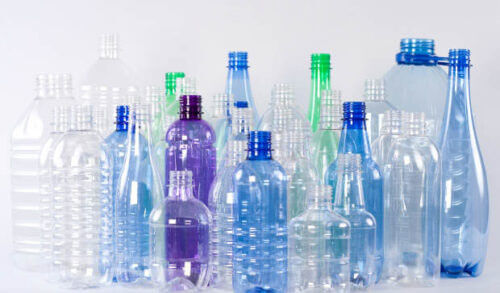
Polyethylene terephthalate is the most commonly used polyester material for disposable water bottles. This material is used to make a number of common consumer items such as soft drink bottles, peanut butter containers, and salad dressing bottles.
This is because this type of plastic bottle can be formed into a wide variety of shapes, sizes, and colors making it an ideal choice when packaging consumer goods. Plastic bottles made of PET material are lightweight, sturdy, shatter-resistant, and provide a good barrier to outside elements such as moisture or chemicals that can affect the contents inside
These types of plastic bottles also have a reliable resistance to cold temperatures making them ideal for use in refrigerators. They will not react with acidic foods or beverages and will not impart off-flavors.
PET plastic bottles are suitable for all kinds of water including distilled, spring, mineral, purified drinking water to name a few. This type of material is also perfect for carbonated soft drinks since it can withstand the pressure inside the container while storing these types of products.
However, it should be noted that PET bottles are not for hot beverages since the material cannot withstand heat. That is why you will never find a disposable water bottle made of this type of plastic in an oven or microwave.
- Pros
- These are very strong and lightweight.
- A wide variety of shapes, sizes, colors making them ideal for packaging consumer goods.
- Reliable resistance to cold temperatures which makes it perfect for refrigerator use.
- Cons
- The contents inside the water bottle may taste like plastic.
- This type of material is not for hot beverages since it cannot withstand heat.
2. High-Density Polyethylene (HDPE) Plastic Bottles
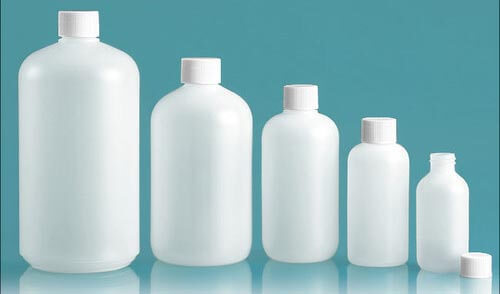
Recognized as one of the most versatile polymer materials, HDPE has some benefits that make it a popular choice for plastic bottles. HDPE is considered safe because of its chemical structure, which makes it inert or inactive in the human body. As its name suggests, HDPE also has a high molecular weight, making it strong and durable.
This type of plastic can be recycled many times without losing quality or strength, which makes it an ‘environmentally friendly’ choice for certain products.
The high density in HDPE products gives the plastic a higher melting point than both low and medium-density polyethylene (LDPE/MDPE), which makes it more heat resistant, but also harder to process during manufacturing. For this reason, most food containers are made from LDPE or MDPE instead of HDPE.
Some of the benefits of using the HDPE material for manufacturing plastic products include:
- Easy to recycle
- Resistant to corossion
- Stronger
- Highly Malleable
- High Melting Point
Adding to the benefits, here are some pros of HDPE:
- Pros
- HDPE bottles are said to be the safest plastic for food and drink storage.
- HDPE bottles do not contain Bisphenol A (BPA), which is linked to many health issues.
- HDPE plastic bottles can be recycled endlessly since they have no toxic chemicals.
- Durable – once a HDPE plastic bottle is made, it can last for long-term use.
- Cons
- HDPE plastic bottles may not be as transparent.
- Lower impact strength which means it could break if too much pressure is applied on them.
- When exposed to extreme heat, HDPE can become soft and lose its shape easily.
- HDPE can be inflexible and rigid.
- Unsuitable for the long-term storage of foods with high water content .
3. Polyvinyl Chloride (PVC) Plastic Bottles
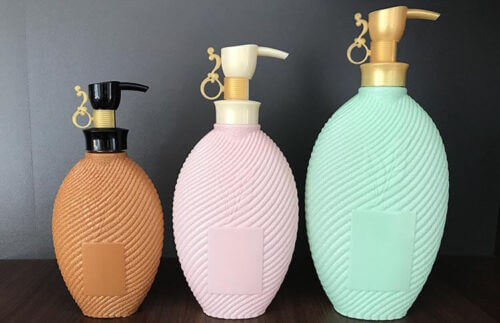
Polyvinyl Chloride (PVC) belongs to the thermoplastic polymers family. It is widely used for making different kinds of plastic materials, including plastic bottles. PVC makes the water bottle clear and shatterproof. On top of that, it also prevents any kind of chemicals to be mixed with your drinking water which means no more worrying about harmful effects on our health.
PVC Plastic Bottles are not biodegradable or recyclable and need to be disposed of as hazardous waste.
Besides being used in the manufacturing of different types of plastic water bottles, PVC is widely used in the construction industry. PVC is resistant to many chemical substances, including strong acids and bases. It does not corrode easily when exposed to different weather conditions.
Hence, it’s used in the creation of pipes for water transport, in the manufacturing of cables and wire insulation, etc. PVS is durable, versatile, and lightweight, which makes it easy and cost-effective to process. With such capabilities, this type of plastic material is suitable for various applications.
- Pros
- Long-lasting - PVC plastic bottles can last up to three years with proper storage.
- Versatile Material - the same type of plastic can be used for many different uses.
- Simple - they are easy to use and take care of.
- Cost-effective - they are inexpensive.
- Cons
- Highly flammable
- May release hazardous substances – not designed to withstand high temperatures.
- Harder to recycle - PVC plastics are very difficult to recycle due to the presence of chlorine.
4. Low-Density Polyethylene (LDPE) Plastic Bottles
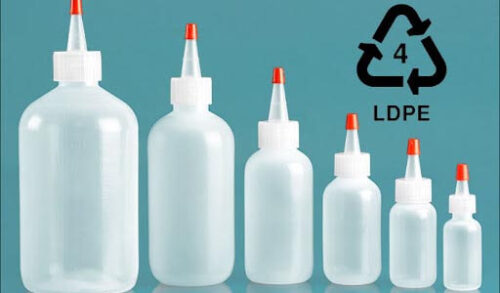
Low-density polyethylene, or LDPE, for short, is a very lightweight plastic, which is used in the production of bottles. It’s also flexible and transparent, making it popular for use in freezer bags. Low-density polyethylene has good chemical resistance to acids (vinegar), alcohols, salt solutions and oil but not solvents or ketones.
If you are looking for a plastic material that can decently pack products that require heat-sealing, then low-density polyethylene is a good material. Due to its minimal density composition, LDPE is mainly used in manufacturing highly flexible and thin plastic products. It has a high recycling rate and is considered a better option than other plastics in terms of protecting the environment.
Below are some of the most common applications of the low-density polyethylene in plastic-based products:
- Dry-cleaning bags
- Newspaper bags
- Garbage plastic bags
- Fresh produce plastic bags
- Bread plastic bags, etc.
Since it also has a high recycling rate, LDPE is becoming a better choice of plastic material for the production of eco-friendly, sustainable products.
- Pros
- Lightweight – LDPE is lightweight which makes it easier to transport and carry around.
- Has good chemical resistance against acids (vinegar), alcohols, salt solutions and oil.
- Cons
- Poor heat resistance.
- High recycling cost.
5. Polypropylene (PP) Plastic Bottles
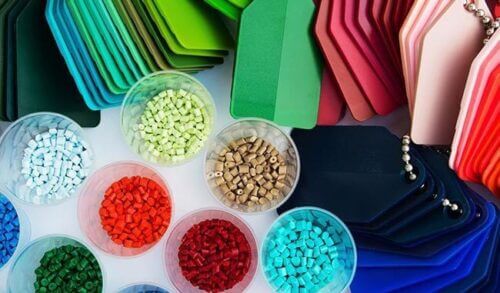
You’ve probably wondered what type of plastic material makes medical devices, packaging trays, and battery cases, right? Well, it’s PP! This material is also used for water bottles. You can find this type of plastic bottle in grocery stores and pharmacies across the nation.
In detail, Polypropylene is a crystalline and rigid thermoplastic that comes from the monomer propane or propylene, hence its name. Commonly used in many applications, this type of plastic bottle is translucent to opaque, has high strength properties, excellent chemical resistivity, and can withstand temperatures from -18 degrees Celsius up to 100 degrees.
Polypropylene contains many forms including homopolymer (un-reinforced), copolymers (addition polymers containing at least two different types of monomers that form the copolymer), and impact modifiers (additives that improve performance).
There are many advantages to using PP bottles including: cap compatibility, ease of molding, safety in medical devices/ equipment & packaging trays due to its non-toxic nature.
- Pros
- Shatter proof.
- Most commonly used type of bottle due to its low price tag.
- Can be recycled more times than other plastics without losing quality.
- FDA approved for direct food contact.
- Cons
- Leakage issues in packaging.
- Not recyclable in most traditional recycling plants.
- Can't be used with oils or alcohols because oil will dissolve the bottle’s wall.
6. Polystyrene (PS) Plastic Bottles
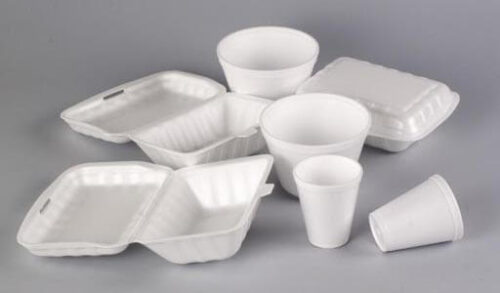
Polystyrene is a rigid plastic made from styrene monomer. It is also known as “Styrofoam”. PS has the lowest weight of all plastics and it costs very little to produce, but its production can be hazardous due to toxicity concerns.
In the 1970s, PS was introduced for making cups and food containers due to its low cost compared with glass or metal. In fact, one of the first consumer products made from polystyrene foam was a coffee cup.
PS is not easily recyclable due to the fact that it consists of beads which are stuck together. So, it can’t simply be melted down and reformed like other plastics. Instead, recycling involves grinding the material into flakes or powder (called “expendables”), then remolding them into new products such as shipping pallets, picture frames and yard furniture.
While the production of polystyrene releases fewer greenhouse gases than most other plastics, it is still a contributor to global warming due to its low decomposition rate in landfill sites.
- Pros
- Cheap to produce.
- Light weight.
- Cons
- Toxic production process..
- Not recyclable.
- Degrades at a very slow rate in landfill sites and contribute to global warming.
7. Other Plastics
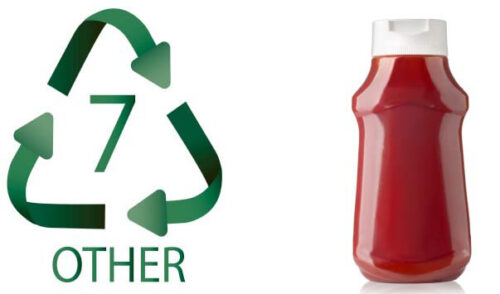
Besides the six types of plastic bottles mentioned above, there are also other types of plastic that can be used for bottling or other uses.
Number 7 plastics or code 7 plastic products are usually made from polycarbonate, LEXAN, or BPA plastic materials. These types of plastics aren’t commonly used in manufacturing, particularly due to their high ability to leach chemicals.
However, they are still widely used to make sippy cups, some care parts, bottles for babies, and water cooler bottles as well. Like explained above, code 7 plastic bottles aren’t recommended for reuse. This is because reusing them can result in leaching chemicals which are dangerous to your health and the environment.
- Pros
- They are typically strong and durable.
- They can be molded into a variety of shapes and forms.
- Cons
- Not recommended for reuse.
- Can release dangerous chemicals if broken down through recycling.
Comparison Between Different Types of Plastic Bottles
PET VS HDPE
| PET | HDPE |
|---|---|
| •The most common use for these types of bottles is to hold beverages, such as water or soda. | •These are commonly used for storing milk and other food products that should not be stored in a container made from aluminum. |
PVC VS LDPE
| Vinyl (PVC) | Low-density Polyethylene (LDPE) |
|---|---|
| •Vinyl or PVC cannot be recycled so easily and is usually used in one-time-use containers. | •LDPE has a lower melting point than PVC, which means it can be reused more often as it’s easier to recycle. |
PS VS PP
Features of Polystyrene (PS)
- PS is one of the cheapest plastics used for making food containers.
- PS is not recyclable and it’s also the most difficult type of plastic bottle to recycle.
- PS plastic bottles are very light, relatively strong, and a good insulator. They can be microwaved but not frozen or exposed to hot liquids over 100 degrees Celsius as they will become misshapen.
Features of Polypropylene (PP)
- PP is a good choice for items that have to be sterilized or stored in the fridge. It’s also recyclable but not very common due to its high recycling cost.
- PP is suitable for carbonated drinks as it can handle high pressure.
- PP plastic bottles are fairly light, impact resistant, and unbreakable. Besides, they cannot be microwaved or frozen but they can withstand hot liquids up to 137 degrees Celsius.
Final Thoughts
Plastic bottles are the most common type of bottle in existence today, but they come with their disadvantages which need to be considered when making decisions about plastic versus glass or aluminum.
We are Jingsourcing, a leading sourcing company based in China dedicated to helping importers customize and wholesale products from China. If you are interested in customizing plastic bottles or importing other products from China, please don’t hesitate to CONTACT US.


Leave A Comment